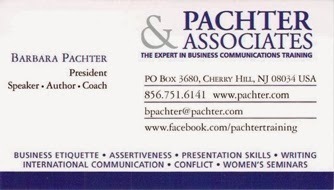The Survival of Business Cards: 6 Tips to Update Them in a Social Media World
Sometimes, the more things change, the more they really do stay the same.
In a recent Boston Globe story headlined Among Tech Crowd, the Paper Business Card Endures, reporter Callum Borchers discusses, in what may be a surprise to some, that business cards haven’t been replaced by technology. He writes: “Of the many things swept away in the outgoing tide of an increasingly digitized economy, the lowly business card has been an odd and unlikely survivor.”
Business cards have always served as a shorthand way to tell people what you do, and provide information for them to contact you. They still do that, easily and efficiently. But because social media has changed the way we connect with our customers, clients, colleagues and prospective employers, your card may need to be updated.
When I gave my revised card to a potential client, she commented that since my Facebook business page (www.facebook.com/pachtertraining) was on the card, it would be easy for her to review the site.
You will have to decide how much to include on your card, and how to do so without overloading it. To help you make that decision, ask yourself these 6 questions:
1. Have I included the necessary information? Think about the majority of your potential clients and customers, and include the information they will need. Usually this means your name, your title, company name/logo, address, phone number, and email and web addresses.
2. What can I eliminate? Is the information on the card easy to read? Make sure your card is visually appealing. Can you eliminate your fax number? Do you need both your business and cell phone numbers? If you have a lot to include, use the back for the less-essential information.
 3. Which social media addresses do I use for business? Include the social media addresses that help you stay in contact with your customers, clients, etc. If adding all your links overwhelms the card, place them on the back. When you hand your card to someone, you can point this out by saying, “If you want to connect with me by social media, my addresses are on the back.”
3. Which social media addresses do I use for business? Include the social media addresses that help you stay in contact with your customers, clients, etc. If adding all your links overwhelms the card, place them on the back. When you hand your card to someone, you can point this out by saying, “If you want to connect with me by social media, my addresses are on the back.”
4. Should I include a quick response (QR) code? These are bar codes that can be scanned by Smartphones to provide a link to your websites, LinkedIn profile, or other pertinent material. If you find using a QR code useful in your field, it usually is best placed on the back of the card.
5. Is a photograph necessary? Most corporate cards do not include photographs, but you may want to include a photograph if you use your card for marketing purposes. If you do so, make sure to use a photograph that looks like you now, and not some unrecognizable version of a younger you. Speakers will often have photographs of themselves on their cards. Information on giving out your cards can be found in my book, The Essentials of Business Etiquette: How to Greet, Eat, and Tweet Your Way to Success.
6. Will an unusual card be helpful? If you use an out-of-the ordinary card—one with an uncommon shape or design—make sure it is appropriate for your field or industry.
One last thing: Always carry your cards with you. You never know when you may encounter someone to whom you want to give your updated card.
Pachter & Associates provides training and coaching on business etiquette and communication. For more information, contact Joyce Hoff at joyce@pachter.com or 856.751.6141.
In a recent Boston Globe story headlined Among Tech Crowd, the Paper Business Card Endures, reporter Callum Borchers discusses, in what may be a surprise to some, that business cards haven’t been replaced by technology. He writes: “Of the many things swept away in the outgoing tide of an increasingly digitized economy, the lowly business card has been an odd and unlikely survivor.”
Business cards have always served as a shorthand way to tell people what you do, and provide information for them to contact you. They still do that, easily and efficiently. But because social media has changed the way we connect with our customers, clients, colleagues and prospective employers, your card may need to be updated.
When I gave my revised card to a potential client, she commented that since my Facebook business page (www.facebook.com/pachtertraining) was on the card, it would be easy for her to review the site.
You will have to decide how much to include on your card, and how to do so without overloading it. To help you make that decision, ask yourself these 6 questions:
1. Have I included the necessary information? Think about the majority of your potential clients and customers, and include the information they will need. Usually this means your name, your title, company name/logo, address, phone number, and email and web addresses.
2. What can I eliminate? Is the information on the card easy to read? Make sure your card is visually appealing. Can you eliminate your fax number? Do you need both your business and cell phone numbers? If you have a lot to include, use the back for the less-essential information.
 3. Which social media addresses do I use for business? Include the social media addresses that help you stay in contact with your customers, clients, etc. If adding all your links overwhelms the card, place them on the back. When you hand your card to someone, you can point this out by saying, “If you want to connect with me by social media, my addresses are on the back.”
3. Which social media addresses do I use for business? Include the social media addresses that help you stay in contact with your customers, clients, etc. If adding all your links overwhelms the card, place them on the back. When you hand your card to someone, you can point this out by saying, “If you want to connect with me by social media, my addresses are on the back.”4. Should I include a quick response (QR) code? These are bar codes that can be scanned by Smartphones to provide a link to your websites, LinkedIn profile, or other pertinent material. If you find using a QR code useful in your field, it usually is best placed on the back of the card.
5. Is a photograph necessary? Most corporate cards do not include photographs, but you may want to include a photograph if you use your card for marketing purposes. If you do so, make sure to use a photograph that looks like you now, and not some unrecognizable version of a younger you. Speakers will often have photographs of themselves on their cards. Information on giving out your cards can be found in my book, The Essentials of Business Etiquette: How to Greet, Eat, and Tweet Your Way to Success.
6. Will an unusual card be helpful? If you use an out-of-the ordinary card—one with an uncommon shape or design—make sure it is appropriate for your field or industry.
One last thing: Always carry your cards with you. You never know when you may encounter someone to whom you want to give your updated card.
Pachter & Associates provides training and coaching on business etiquette and communication. For more information, contact Joyce Hoff at joyce@pachter.com or 856.751.6141.
Published on January 08, 2014 09:38
No comments have been added yet.



